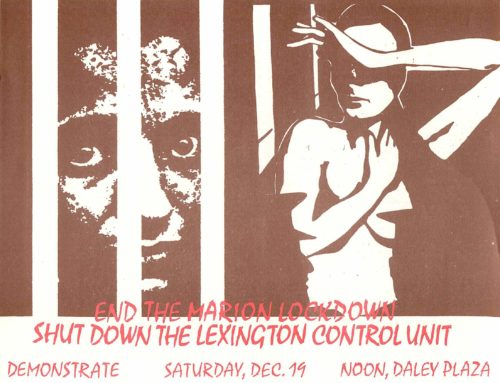Out of Control: Chapter 10–Lexington Victory, 1987 Continued
Although for every victory we also seemed to be dealt a defeat, there had been some substantial victories. Political prisoners Sundiata Acoli and Sekou Odinga were transferred out of Marion—in large part, they believed, because of our protests. Unfortunately, we heard on the day of our Tribunal that political prisoner Alan Berkman was now designated to arrive at Marion in the following week. In December curtains were finally installed in the women’s showers in Lexington and the ban on visits by grandchildren was lifted. Such was the nature of our struggles and occasional victories.
Most significantly, just weeks before the Tribunal, on October 5th, the BOP announced the Lexington Control Unit would be closed, although not for another nine to eleven months, and they indicated they would build a bigger unit elsewhere. We rejoiced at the prospect of the closing, but initiated a letter-writing/telephone campaign to demand it take place immediately, insisting as well that they desist from building any other “torture unit for women political prisoners.” It let them know that if they went ahead with such plans, we would continue to protest.
Within less than two years, a popular movement and a lawsuit brought by Jan Susler and other attorneys had been successful in shutting down the Lexington Control Unit.
I shared in the joy of that victory but have always had mixed feelings about these events. On the one hand, it was wonderful to see so many people involved in the Lexington work. On the other hand, the victory came relatively quickly and the same energy was not then applied in the case of the men’s control unit at Marion. In addition, I felt criticism from some women in my own organization, the Prairie Fire Organizing Committee (PFOC), about not including women’s issues in my work. And I felt I wasn’t heard when I argued for the priority of work around prisons generally. If it wasn’t about women or it wasn’t about political prisoners, I thought they saw it as less important.
At the same time, I did believe it was important to focus on women’s issues, and yet it was hard to figure out how to do that within the Marion work. When South End Press agreed in 1989 to publish a book on prisons that Steve and I would edit, I jumped at the chance to write a historical piece about women in prison. We worked long and hard on that book, but subsequently had political disagreements with a new South End editor, and, unfortunately, the book was never published. Luckily for me, the internet exploded and my piece was all over the place, convincing me in a personal way of the importance and potential of this new technology. “Women and Imprisonment in the U.S.: History and Current Reality” can still be found in various forms on the internet but I doubt the South End book would have been accessible today. The piece also continues to be reproduced in many editions of a textbook used in women’s studies courses, Women’s Lives (McGraw Hill, Kirk & Okazawa-Rey).
With the victory of Lexington behind us, we knew the work around Marion would be a protracted struggle. The Chicago Puerto Rican community that had lent its essential energy to the work thus far around Marion, as well as Lexington, continued its commitment to the work. We could hardly withdraw now.


